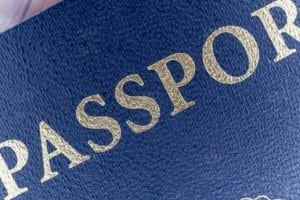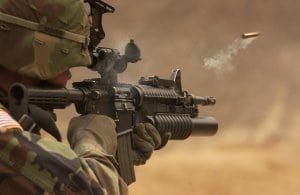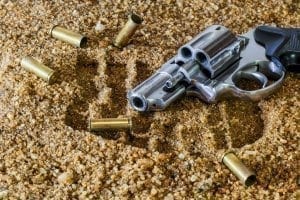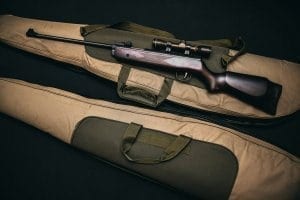The CMP (Civilian Marksmanship Program) is a program designed to educate and train citizens of the U.S. in how to responsibly use air guns and firearms. The national organization does this through competitions, marksmanship training, and firearm safety training. We will cover each of these in detail in this article.
Purposes of the Program
The Civilian Marksmanship Program is considered a federally chartered corporation and places a high priority on bringing gun safety to youth. In addition, they focus on marksmanship activities, building life skills, and personal growth for those involved. The CMP was created to provide the following functions:
-In order to help people use firearms in a safe and responsible way
-To show U.S. citizens how to practice marksmanship
-And to create competitions for the safe use of guns and to give badges, prizes, trophies, and more to its competitors.
The laws around this corporation state that the CMP corporation must prioritize activities related to training, competition, and firearm safety for youth. There is also the goal of reaching as many youth members as it can.
About the Civilian Marksmanship Program
Whether you want to know how to participate in CMP competitions, wish to find a local clinic or club, want to buy your own firearm equipment, or you’re just curious, this article will help you.
Leadership and Governance
There are 11 directors who control the Civilian Marksmanship Program. These individuals have experience with business, the military, and leadership and use these skills in the program. The involved members include a Chief Operating Officer, Chief Executive Officer, and more. The Civilian Marksmanship Program focuses heavily on firearm safety due to legal requirements. The competitions offered by the program are one way it enforces this. The competition enables those who participate to develop their skills and win awards for this with incentives.
Firing Schools in the CMP
There are Small Arms Firing Schools involving pistols and rifles that enable people to learn the basics of marksmanship via direct instruction and help. In this class, the ammunition, rifles, and pistols are given to the students. To get involved with a particular discipline, you can contact the CMP Director in your specific state.

Those who compete in these activities can also join a club for those affiliated with the Civilian Marksmanship Program. If you’re interested, simply search for a club near you as these programs offer matches and clinics that you may be involved with.
How Can You Get Involved?
Legally, the Civilian Marksmanship Program is allowed to sell surplus military ammunition, firearms, and other items. But these are only available to CMP club members who are older than 18, live in the United States, and can legally buy a gun. What do you need to start getting involved with the CMP?
Requirements for Involvement
First, you have to prove that you’re really a U.S. citizen. To do this, provide an official government document that shows your identity.
Proof of Citizenship:
This can mean proof of naturalization, your passport, or American birth certificate. You may use a military ID, but it has to be at least an ES to qualify. The document has to show that you were born in the United states or that you have legal law enforcement status (this last part only applies to federal officers). You also need to show your age, but usually your document that shows proof of American citizenship will show that. If it doesn’t, you can provide your driver’s license.
CMP-Affiliation:
Next, you need to show that you are involved in a CMP club by showing a current membership card or some other proof. The program requires this without any exceptions. The Civilian Marksmanship Program has more than 2,000 of these organizations in the U.S., so you can find out how to join easily. Then ask the club to fill the CMP Membership Form for you and turn it in with your order.
In order to gain membership in these organizations, the cost is typically $25.00 or so and you can join online. You may also go to the Club Search page mentioned earlier or call the Civilian Marksmanship Program at 256-835-8455.

Marksmanship Familiarity, Experience, and More
To get involved, you have to show that you have participated in marksmanship or that you are familiar with handling guns and range procedures with safety. This familiarity need not be with high-power rifles and can instead just include small-bore rifles, shotguns, air guns, or pistols.
Proof of Experience
You can prove that you have participated in marksmanship with any of the following documents:
-A license for Concealed Carry
-Status as a coach or instructor for related activities
-Forms that show past or current service in the military
-Past or current service in a law enforcement agency
-Firearm competition participation (show results bulletin)
-Live firearm training from a marksmanship clinic
-C&R or FFL license, Firearms Owner ID cards that involved training in live fire
-Hunter Safety course completion that involved training in live fire
-Certificate from law enforcement or club official who witnessed shooting
Fill the Civilian Marksmanship Program form to officiate your experience with range firing. You don’t have to prove your marksmanship if you’re older than 60 years of age. However, the program requires proof of U.S. citizenship and club membership no matter how old you are. Please keep in mind, though, that the program doesn’t require marksmanship activity proof to buy parts, memorabilia, publications, or ammo.
Legal Eligibility for Buying a Firearm
When you fill out the application form for the Civilian Marksmanship Program, this information will then be passed on. It goes to the NICS (National Instant Criminal Check System) in order to verify that you can legally possess or acquire a rifle. When you sign the Purchaser Certification section of your purchase application, this gives the CMP authorization to start this check and tell the CMP what the results are.
If the state or locality you live in requires that you need a permit, license, certificate, or Firearms Owner identification to buy or have a rifle, you need to include proof of this with your purchase. This can mean a photocopy of your card, permit, license, or certification.

Specific State Requirements
Note that rifle shipments to New Jersey and New York have to be made with a dealer that is legally licensed in the state. You need to also give a photocopy of the firearm dealer’s license when you submit the order form. Rifle shipments to California have to be made with a dealer licensed in the state or can involve individual homes as long as there’s a Certificate of Eligibility legally valid in the state. You may also need the required Curio and Relic License. In Connecticut, rifle shipments have to be made only to dealers and those who are licensed, or can be sent to the customer directly as long as the required C&R license was shown.
Why Would You Join the CMP?
Both clubs and individuals stand to benefit from becoming affiliated with the Civilian Marksmanship Program. This is a great way for people to get access to facilities, professional training, the necessary equipment, and the overall aim of becoming a better marksman. Below, we will outline some of the program services that are available to people associated with this program. Guidelines for eligibility might apply to some programs, so make sure you find out what applies to your specific situation.
On the Mark
Every Civilian Marksmanship Program affiliate will get a newsletter specifically produced for junior shooting coaches and leaders. This offers tips for running and instructing junior programs. It also comes with announcements, program brochures, and information about competition and training availability for youth. To get any of your questions answered for this publication, email the Communications Department of the CMP at onthemark@thecmp.org.
The First Shot
The First Shot is the official Civilian Marksmanship Program newsletter. The online publication gives updates on any new programs available, along with any new changes, and information about relevant or major events or activities. You can sign up for CMP updates and emails in order to stay current with new issues they post.

Rifle Sales Program
There are some government surplus firearms for sale to those affiliated with CMP clubs and they come with special discounts. Any clubs affiliated with the CMP will get a discount of 10 percent on these firearms. In order to receive this discount, use the Sales Order Form for Club Rifles.
BBs, Pellets, and .22 Ammo for Sale
There was once a government program that gave small-bore surplus government ammo to clubs affiliated with the DCM for free. However, this ended in FY2000 because the supply of small-bore ammunition was exhausted. The Civilian Marksmanship Program replaced that with bulk-purchase contracts that consistently make available affordable ammunition especially useful for junior marksmanship members.
All of those affiliated with the CMP, whether special or regular members, are able to buy as much of this ammunition as they want if they agree to sponsor training for youth marksmanship. These .22 caliber ammunition, BBs, and air rifle pellets are sold at low Civilian Marksmanship Program costs. The overall costs are as low as possible as long as the purchases are made in volume.
The M1 Garand Sales Program
If you are a qualified citizen of the United States and also a member of a club affiliated with the CMP, you might be eligible to buy a M1 Garand Rifle. These firearms will be priced and graded based on the condition they are in. The Civilian Marksmanship Program also sells some target rifles of .22-caliber that the military produced specifically for training purposes.
Rifle Purchase Program
Another benefit for those affiliated with the CMP is the Rifle Purchase Program. This program allows camps, teams, junior clubs, and schools that are affiliated with the CMP to buy specific rifles for competition and target training by beginner or intermediate shooters. If the rifles are out of the buyer’s price range there’s a delayed payment plan offered by the program that distributes payments over a couple years.

Sanctioned Games Matches
Over time, something called Sanctioned CMP Games Matches became increasingly popular and prevalent. The competition only allows M1 Garand rifles that are still in their original, “as-issued” condition. The Civilian Marksmanship Program introduced this National Matches event, the John C. Garand Match in the year 1999. These matches feature a fire course available to shooting sport enthusiasts, even if they have no formal experience with target shooting. However, it’s difficult, even for competitors with a lot of experience.
Growing Popularity
This match, once instituted, was a success right away and showed how competitions for those who enjoy target shooting recreationally can become widely popular and sought-out. The match started with a little more than 300 competitors the first year, and then quickly grew to the biggest single event of the National Matches. The number surged from 300 to about 1,400. Then, in the year 2002, the Civilian Marksmanship Program started two more events with similar principles.
Tracking Competitions
Camp Perry hosted a Vintage Military Rifle event that brought in more than 600 competitors by the second year. And a new Rifle Match with Rimfire Sporters has a national Camp Perry event that hosts club matches that continue to grow. Each of these competitions were designated by the Civilian Marksmanship Program as CMP Games matches.
In order to make them available to club members, the program sanctions Rimfire Sporter, Carbin, Vintage Military Rifle, Club Springfield, and Club Garand events and matches. The program has also instituted a Vintage Sniper Match to its sanctioned matches. Those who are interested can keep track of upcoming events and matches on the online CMP Competition Tracker.
Marksmanship Clinic Involvement
The Civilian Marksmanship Program offers instructional clinics by organizations with affiliation in one of its older programs. These allow people in their areas to fulfill the CMP participation requirement for marksmanship and to be able to buy CMP rifles. A lot of the clinics are named “Garand Clinics.” They offer an introduction to range firing, target firing for junior and adult shooters, along with firearm safety training for those involved.

The Civilian Marksmanship Program gives educational materials and affordable ammo for these clinics. Just recently, over 100 of the clinics were CMP-sanctioned and gave education and instruction to 1,800 people.
Sponsorship Benefits
In order to aid sponsors with clinic promotion, the Civilian Marksmanship Program posts updated information on sanctioned clinics on the Internet.
Then, once the sponsor gives a report on the number of individuals who went to the clinic, the CMP provides clinic completion certificates. The individuals are then able to use the certificates to show that they completed marksmanship training. Then they may buy government-surplus firearms from the Civilian Marksmanship Program. The Competition Tracker lists sanction clinics, along with the event information previously mentioned.
EIC Program Matches
The Distinguished Pistol Shot and Distinguished Rifleman Badges are two prestigious CMP awards. Competitors win these badges in the Excellence-in-Competition (EIC) competitions, using service pistols and rifles. The Excellence-in-Competition program has standards of competition, maintains records for individual shooters. The program gives points and presents medals and badges.
In order to gain distinguished status in this, individuals must earn 30 points over a series of competitions that might last for years. Only Civilian Marksmanship Program-involved organizations may apply to run these matches. More information on these matches is available on the CMP Competition Tracker.
Civilian Marksmanship Program Clubs
As you’ve probably noticed by reading the previous sections of this article, being affiliated with CMP clubs is necessary. This important step helps in developing a beneficial relationship with the program as a whole. Since a Civilian Marksmanship Program membership doesn’t technically exist on its own, the most effective way to get involved with the programs available or buy things through the stores is to be a member of one of these clubs. Or perhaps you’re involved with a club that is looking to become affiliated with the CMP. We will cover both scenarios below in detail for you.

Clubs Seeking CMP Affiliation
If you are involved with a club that is seeking CMP affiliation, the program can help your club reach its goals. And the CMP welcomes opportunities to reach their vision and mission of promoting safety and training for U.S. citizens, especially youth. There are a series of steps you will have to go through to complete this process. You can reach the Affiliate Relations Department of the Civilian Marksmanship Program at 419-635-2141, just dial extension 753. There is also an email you can write to for this department (clubs@thecmp.org) to get specific answers for your questions.
What do You Gain?
If you’re someone looking for competition, education, or discovery in shooting sports, being a member of a club affiliate with the CMP can make all the difference in the world. When you join one of these clubs, you get access to experienced shooters, great facilities, competition, and clinics that the average shooter doesn’t have access to.
Finding a Club
Whether you like shooting pistols, air guns, high-power or small-bore rifles, there’s likely a club affiliated with the CMP that can help you gain more knowledge. This is a great way to learn more about the sport and make sure you’re always practicing safety. When you join a club affiliated with the Civilian Marksmanship Program, you are allowed to go to sanctioned events and matches. Again, you can look for CMP clubs near you to benefit from this.
Individual Seeking Club Membership
There are more than 2,000 CMP-affiliated organizations in the United States at this time. Legally, the Civilian Marksmanship Program can sell surplus parts, ammunition, firearms, and other items from the military. But again, they may only sell them to people who belong to clubs affiliated with the CMP, who are able to legally possess or buy a gun and are over 18 years of age.

As stated earlier in the article, you have to present proof of membership or a photocopy of your up-to-date membership card. In order to get membership with one of these clubs, you have to pay a small fee, and most of them allow you to join online. This article has already given a lot of detail on the benefits of joining, so just check out the club search to find the right one for you. Or, if you’d rather have someone help you find the right club, email CMP Customer Service at custserve@odcmp.com or call 419-635-2141 (extension 753).
More on Special CMP Affiliates
But it isn’t just shooting clubs that the Civilian Marksmanship Program offers. They also have some special affiliates. These include MCL, DAV, VFW, and other veterans’ organizations. In addition, these affiliates include U.S. military services, and active or retired members of the National Guard. There are also some law enforcement associations and groups involved, like the NSA, NAPO, and the FOP.
*Keep in mind that club membership is a requirement for those who wish to purchase ammo, parts, or rifles.
CMP Competitions
The Civilian Marksmanship Program places heavy emphasis on competitive marksmanship for those involved with the organization. It both reinforces safety for firearms and enables those who compete to improve in their marksmanship with incentives. For those who are new to the world of competitive shooting, the CMP delivers. The Program and the organizations connected to it often sponsor workshops to help.
Short-term Courses
The program highly recommends that newcomers participate in the Small Arms Firing School at Camp Perry in Ohio state. When members complete the one or two-day courses, they receive the basics of marksmanship and firearm safety. Again, don’t hesitate to contact the CMP directly if you have any questions.

National Matches for the CMP
The Civilian Marksmanship Program National Matches were held in 1903 at first, then the program moved them to Camp Perry in the year 1907. These Matches have turned into a nation-wide sports festival with thousands of participants each year. The event shooters and school students involved with this range from newbies to the best in the world.
Events and Activities
Included in these National Matches are CMP Games Events, Pistol and Rifle Matches by the CMP, and the previously mentioned Small Arms Firing Schools. The law legally mandates these firing schools. As of the year 2018, the Civilian Marksmanship Program added both Long Range and Small-bore Matches to their schedule. The organization takes care of its responsibility to put on National Matches by working with the National Guard in Ohio as a partnership. In addition, the National Pistol Championships of the NRA take place in Ohio at Camp Perry.
The First Shot
There is an opening segment featuring a First Shot Ceremony at these matches. Each year, there is a guest who comments to the present competitors, government leaders, local military, volunteers, and officials at the match. There are hundreds of people at these ceremonies annually. As soon as the speaker makes his or her comments, they get the privilege of firing off the ceremony’s first shot.
Petrarca Range and CMP Targets
Present in Ohio at Camp Perry, the Petrarca Range features CMP targets. These are new and electronic, with the technology made possible by KTS (Kongsberg Target Systems).
The Importance of Safety in the CMP
This may come as a surprise to some, but target shooting is one of the safest sports due to its safety rules. Everyone must both learn and adhere to these basic guidelines as to prevent any unfortunate accidents. In the United States, there are thousands of JROTC rifle groups, junior shooting clubs, Boy Scout groups, 4H shooting clubs, junior organizations, and youth camps that conduct air rifle activities. Altogether, groups like this have over 100,000 individuals participating in the country.
Preventing Accidents
These activities have an amazing record of safety and accidents related to firearms are very rare. And marksmanship activities are, as briefly mentioned before, some of the safest sports that youth can participate in. Target shooting involves and requires discipline, control, and a strict adherence to the safety guidelines at every single moment. Organizations like the Civilian Marksmanship Program ensure that the sport stays this way. They help youth learn and stick with these important rules to prevent accidents and mishaps.
More about the CMP and Firearms Safety
Again, safety is one of the most important priorities for the Civilian Marksmanship Program, as enforced by the federal law in America. The law states specifically that a main function of this organization is to help promote safety and practice with marksmanship and firearms. The program also must help citizens of the U.S. know how to use them properly. Due to this, the organization creates a few different types of safety materials which people can order through their e-store.

Safety Tips Taught by the Program
-Unloaded Firearms: You should never load a gun unless you are using it or getting ready to use it. Unless there’s a need to load a firearm at that moment, just don’t load it. Don’t ever unload or load your firearm in a building or vehicle since there’s no safe place to point it.
–Obstructions: The shooter should always check for barrel obstructions if there’s reason to believe a blockage might be in place. These can lead to firearm explosions.
–Target Identification: The person shooting must always positively identify their target and know that a safe backstop is behind before they shoot their firearm. The shooter shouldn’t ever shoot at water, a flat surface, or a hard object as this can be dangerous.
How to Hold the Gun
An individual must always hold the gun in a way that allows for control over the direction it’s pointing. They need to make sure this is true even if they stumble or fall on accident. No one should pull the firearm by the muzzle or allow someone else to point one in their general direction.
Sober Shooting
Never use any firearm, in any situation, if you’re under the influence of drugs or alcohol. The person handling the gun should always have an alert, clear mind. You must never put a loaded gun down or leave it without responsible adult supervision. As soon as you load the gun, keep it in your hands at all times. Also be sure to unload the firearm before you set it down in any situation.
Safety Tips for Handling a Gun
–Where to Point: The individual holding the gun must always point it in a safe direction, no matter what. They need to never point the muzzle at someone else, no matter the circumstance. On a shooting range, they need to keep the muzzle pointed either downrange in the direction of the target.
–Trigger Guidelines: Never place your fingers on the trigger until you have the proper shooting posture. Only do so once you’re ready to shoot the firearm. It’s also important to keep your finger off the trigger when you are getting ready to place the gun into shooting position. Or if you’re loading the firearm.
Firearm Action
When someone handles a firearm, the gun’s action has to be open. Do this with an Open Bold Indicator (OBI), Empty Chamber Indicator (ECI), or Clear Barrel Indicator (CBI) inserted. This is true unless you are present on the firing line at that moment or preparing your firearm for shooting.
What about after you’ve fired your gun? As soon as you have done this, you need to open the action and place the OBI, ECI, or CBI inside. Also, you have to close the action when you’re placing the gun back in the storeroom or gun case. As soon as the individual picks it up again, they must insert the OBI, ECI, or CBI immediately.
Muzzle, Action, Trigger
A simple way to keep the guidelines of gun safety in mind is to remember “MAT,” or “Muzzle, action, trigger.” This is helpful because you have to apply these safety actions in this order. Whenever someone holds a rifle, they need to start with controlling the gun’s muzzle.

How to Correctly Pick a Rifle Up
When someone picks a rifle up or takes one from someone else, they must grab it with their fingers on the outside of the gun’s guard. They need to remember to never place their index finger on the trigger accidentally. They should keep that in mind as they take the gun from someone or pick it up. This is one of the first rules that someone new to guns has to learn.
Later on, the individual will learn when they can place their finger inside the guard. Someone should only put their index finger inside this guard when they are beginning to aim at their target. Holding the firearm with their fingers on the outside of this guard helps ensure safety.
Additional Safety Guidelines
Along with learning basic rules for safe firearm handling are basic safety procedures. Along with these and established range, people who use guns should also keep a couple of important things in mind:
Helping to Keep Others Safe
Whenever guns are present, everyone should act as a safety officer when necessary. If there’s an emergency or safety hazard happening in front of you, you should correct them. For example, if they forget to open the firearm’s action or close the action at the wrong time, you should step in and help.
Focus and Discipline
Firearm safety isn’t just about memorizing rules and leaving it at that. You have to always constantly remember to practice safety control, keeping your fingers on the outside of the guard each time, and checking the action. This will require constant focus and discipline for the safety of yourself and others.
Ear and Eye Protection
Every person who participates on a practice gun range should wear shooting or eye glasses to keep their eyes safe. In addition, they should wear either ear muffs or ear plugs so they can protect their hearing. Your hearing and vision are valuable so make sure you protect them at all times. At a shooting range, always check to see if the people around you have their protection on before you start shooting. This is common courtesy and respect.
Anyone who goes through marksmanship training and safety guidelines will learn the best way to handle a firearm or rifle with complete safety. By following and learning all about the rules with this topic, and making sure you always stick with them, you will stay safe. Not only that, but you will also gain experience in effective, skilled shooting without having to worry.
Safely Transporting Firearms
Any time someone transports firearms or rifles from the range to their home, they should take special precautions for doing it the correct way. There may be laws about this depending on the state you live in, so always check that first. But these are some guidelines that everyone handling firearms should strictly observe for their own safety and that of others:
Double Check
Always keep your guns unloaded. Even if you closed the action already while you are transporting it, always double check it to make sure you have cleared both the magazine and chamber. Once you arrive to the shooting range with the gun or guns, insert an ECI and open the gun’s action.
Use a Case
Any time you are transporting a gun, put it into a locked, protective case before placing it in your vehicle. And if you’re carrying it onto some form of public transport, ask the carrier before you get on board whether this is okay.

Safely Storing Firearms
Any time you are not holding your firearm, you need to put it away immediately. The most important rule in storage for guns is putting them somewhere safe. Safe means somewhere that doesn’t allow an untrained or unauthorized person to get to them. Young children, especially those who don’t have training in firearms, should never have access to them. Storage procedures for guns not only protect against these scenarios, but also against theft or damage.
Gun Storage Rules
Always remember the following when you’re storing your guns or rifles:
–Cleaning and Oiling: Before you put your firearms away, oil them lightly and clean them.
–Check Again: You should always check to make sure you have unloaded your gun before putting it away. After that, check it once more for good measure. Also make sure it’s clear, then you can close its action, release the tension, and lock it up.
-Use the Right Storage: Firearm owners need to use a locked cabinet, safe especially for guns, or other equally secure device for storing any and all firearms.
–Trigger Lock: You should use a trigger lock to prevent unauthorized people from accessing your guns. This is especially important if you don’t have them locked away. When you take your gun out of storage, open the action and keep it open as you handle it.
More about the Trigger Lock
The trigger lock covers the trigger guard and trigger. This means that no one can pull or access trigger on accident once locked. These locks have two pieces and you may secure them with a locking mechanism or key. You shouldn’t ever use these mechanisms for a loaded gun or as a replacement for safe handling of guns. Only a responsible and well-trained individual should be in control of this combination or lock key. You can find rifle-compatible trigger locks and buy them from the Civilian Marksmanship Program.
Storing and Using Your Firearm Ammo
Your ammunition should only be of the highest quality according to American standards. You need to keep it in good condition, dry, and clean. Always only purchase the correct caliber and type for your specific firearm or rifle. Not adhering to this rule can lead to blown-up guns or malfunctions. Store the ammo in a different place than your firearms just for extra safety.
What other guidelines should you observe when it comes to firearm ammunition? Keep your ammunition locked up in a secure place. And only allow a responsible, trained adult individual to access it, no matter what. Observing these rules will ensure that you keep yourself and others safe any time you or they use any firearms.
Conclusion
As you can see, the Civilian Marksmanship Program has a lot to offer U.S. citizens. Don’t hesitate to get in contact with one of their staff. This will help if you wish to learn more about safely handling firearms, marksmanship, or more.
